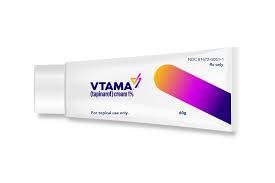Vtama
Pronunciation: Vee-TAM-uh
Generic name: tapinarof
Dosage form: cream 1%
Drug class: Topical antipsoriatics
What is Vtama cream?
Vtama is a steroid-free, once-daily cream used to treat atopic dermatitis and psoriasis, and can be used long-term. Vtama cream helps to clear skin and reduce itch in plaque psoriasis for adults and atopic dermatitis in adults and children 2 years and older. Vtama cream can be applied to all body areas, including sensitive skin areas like your face, neck, armpits, chest/breasts, and groin but should not be applied to your eyes, mouth, or vagina.
Vtama mechanism of action is not fully understood, but the active ingredient, tapinarof, activates a protein in the skin called AhR, which reduces inflammation, improves itch, and helps clear plaque psoriasis and atopic dermatitis by normalizing skin barrier proteins, and increasing antioxidant activity. Vtama (tapinarof) is from a class of medicines called aryl hydrocarbon receptor (AhR) agonists.
Vtama FDA approval was received on May 24, 2022, for the treatment of plaque psoriasis in adults, then on December 16, 2024, Vtama cream FDA approval was extended to include the treatment of atopic dermatitis in patients 2 years and older.
How well dose Vtama work?
How well does Vtama work for psoriasis (plaque)?
Vtama for psoriasis starts to work as early as four weeks, and after 3 months, 40% of psoriasis patients had clear or almost clear skin in the clinical trials PSOARING 2 [NCT03983980].
How well does Vtama work for atopic dermatitis?
After 8 weeks of using Vtama for atopic dermatitis 45.4% patients had a “Clear” or “Almost Clear” score for their eczmea and at least a 2-grade improvement from baseline in the Clinical trial ADORING 1 [NCT05014568].
Vtama Side Effects
Common Vtama side effects
Common Vtama psoriasis side effects may include:
- folliculitis which is redness or crusting around your hair follicles (20%),
- stuffy nose and sore throat (11%),
- skin rash or irritation (7%),
- itchy skin (3%),
- headache (4%),
- flu-like symptoms (2%).
Common Vtama side effects for atopic dermatitis include:
- upper respiratory tract infection (12%),
- redness or crusting around your hair follicles - folliculitis (9%),
- lower respiratory tract infection (5%),
- headache (4%),
- asthma (2%),
- vomiting (2%),
- ear infection (2%),
- pain in extremity (2%) and,
- pain in the stomach area (1%).
Serious Vtama side effects
Get emergency medical help if you have signs of an allergic reaction, such as hives, difficulty breathing, or swelling of your face, lips, tongue, or throat.
This is not a complete list of side effects, and others may occur. Call your doctor for medical advice about side effects. You may report side effects to the FDA at 1-800-FDA-1088.
Related/similar drugs
Opzelura
Opzelura (ruxolitinib) cream is used for the treatment of atopic dermatitis and vitiligo. Includes ...
Eucrisa
Eucrisa (crisaborole) is used to treat mild to moderate eczema (atopic dermatitis) Includes Eucrisa ...
Adbry
Adbry (tralokinumab-ldrm) is an interleukin-13 (IL-13) inhibitor that may be used to treat adults ...
Cibinqo
Cibinqo (abrocitinib) tablets are used for the treatment of moderate to severe eczema (atopic ...
Otezla
Otezla (apremilast) is used to treat plaque psoriasis, psoriatic arthritis, and oral ulcers ...
Skyrizi
Skyrizi (risankizumab) is used to treat plaque psoriasis, psoriatic arthritis, ulcerative colitis ...
Dupixent
Dupixent is used to treat eczema, eosinophilic or oral-corticosteroid-dependent asthma, chronic ...
Stelara
Stelara (ustekinumab) is used to treat Crohn's disease, ulcerative colitis, plaque psoriasis, and ...
Rinvoq
Rinvoq (upadacitinib) is used to treat rheumatoid arthritis, psoriatic arthritis, atopic ...
Important information
This cream is for use on the skin (topical use) only, it should not be applied to your eyes, mouth, or vagina.
Before using this medicine
Before you start treatment, tell your healthcare provider about all of your medical conditions, including if you:
- are pregnant or plan to become pregnant as it is not known if this cream will harm your unborn baby.
- are breastfeeding or plan to breastfeed as it is not known if this cream passes into your breast milk. Talk to your healthcare provider about the best way to feed your baby during treatment.
What other drugs will affect Vtama cream?
Medicine used on the skin is not likely to affect or be affected by other drugs you use.
Tell your healthcare provider about all the medicines you take, including prescription and over-the-counter medicines, vitamins, and herbal supplements.
How should I use Vtama cream?
- Apply once daily to the affected skin in a thin layer. Avoid applying the cream to unaffected areas of your skin.
- Wash your hands after applying the cream unless you are using it to treat your hands.
- If someone else applies the cream for you, they should wash their hands after application.
- Use the cream exactly as your healthcare provider tells you to use it.
Vtama Dosing information
Usual Vtama Dosage: Apply a thin layer of cream to affected skin areas once daily.
Storage
- Store at room temperature between 68°F to 77°F (20°C to 25°C).
- Do not freeze the cream.
- Protect the cream from exposure to excessive heat.
- Keep all medicines out of the reach of children and pets.
Ingredients
Active ingredient: tapinarof
Inactive ingredients: benzoic acid, butylated hydroxytoluene, citric acid monohydrate, diethylene glycol monoethyl ether, edetate disodium, emulsifying wax, medium chain triglycerides, polyoxyl 2 stearyl ether, polyoxyl 20 stearyl ether, polysorbate 80, propylene glycol, purified water, and sodium citrate dihydrate.
Company
Vtama Dermavant Sciences Inc., 3780 Kilroy Airport Way, Long Beach, CA 90806.
References
More about Vtama (tapinarof topical)
- Compare alternatives
- Pricing & coupons
- Reviews (36)
- Drug images
- Side effects
- Dosage information
- During pregnancy
- FDA approval history
- Drug class: topical antipsoriatics
- Breastfeeding
- En español
Professional resources
Related treatment guides
Further information
Always consult your healthcare provider to ensure the information displayed on this page applies to your personal circumstances.

